| Columns Retired Columns & Blogs |
Outlaw Audio RR2150 stereo receiver Sample 2 Measurements, January 2008
John Atkinson wrote about the RR2150 in January 2008, Vol.31 No.1
Footnote 1: Originally priced at $599, the Outlaw now costs $649, and is sold factory-direct by Outlaw Audio, P.O. Box 975, Easton, MA 02334. Tel: (866) 688-5292. Web: www.outlawaudio.com.
Michael Fremer raved about the RR2150 stereo receiver ($649) from Outlaw Audio (footnote 1) in the March 2006 issue of Stereophile: "Give a listen to this $599 receiver," he concluded, "You'll be in for a big surprise—especially if you have megabuck electronics. If this was sold through the usual channels instead of exclusively online, it would cost twice as much and still be worth every cent." But following that review, there was a glitch in supply as Outlaw was forced to move production from the original factory in mainland China to another.
To ensure that our review findings would still be valid for units made by the new manufacturer, I asked Outlaw to send me a sample representative of new production. The original review sample had no serial number; the second sample, which looked identical, was serial no. 6481-H2018. (The measured performance of the first sample can be found here.)
Like the first sample, the new RR2150 ran very hot during the usual one-hour, one-third–power preconditioning, and also like the earlier sample, it didn't turn itself off during this period, and its THD+noise percentage remained low, at 0.007%. The overall gain for line-level signals was almost 3dB lower than that of the original sample, at 40dB, this made up of 11.8dB gain from the preamplifier section and 28.2dB from the power-amplifier section. The latter value is identical to the first sample's; the reduction in gain comes from the preamp section. In any case, the difference is trivial. The preamp output impedance and power-amp input impedance were identical to those of the first sample.
As with the first sample, the input impedance for line-level signals was a relatively low 15k ohms, dropping slightly at 20kHz to 13k ohms. Other than at low frequencies, the phono-stage input impedance was rather lower than the specified 47k ohms, at 30k ohms at 1kHz, dropping to 8k ohms at 20kHz. Moving-magnet cartridges might sound a little mellow as a result. The phono-stage gain when set to MM was still high, at 50dB, but the signal/noise ratio was significantly better, at 72.9dBA ref. 5cm/s at 1kHz. The unweighted wideband figure was 67.2dB compared with the original sample's 58.5dB. Phono-stage distortion again appeared to be very low, at around 0.02% in the midband, and overload margin in MM mode, measured at the tape output, was 15–16dB across the audioband ref. 1kHz at 5mV input signal. Though this is not in the same class as the original sample's 30dB, it's still good.
The response of the original sample's phono stage had shown rather more RIAA error than I'm used to, with a 0.75–1dB trough apparent in the lower midrange (fig.1). The rise above the audioband is presumably due to the de-emphasis conforming to the "enhanced" RIAA curve, something I've criticized before in these pages. The second sample had a very much flatter RIAA response (fig.2), with excellent channel matching given the RR2150's low price.
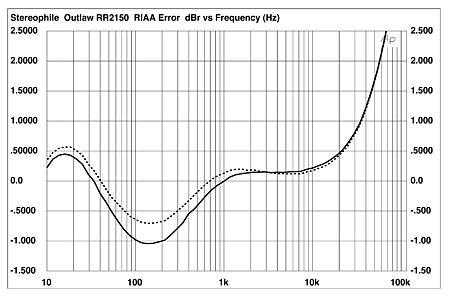
Fig.1 Outlaw RR2150, sample 1, RIAA error, MM input measured at preamp outputs (0.5dB/vertical div., right channel dashed).
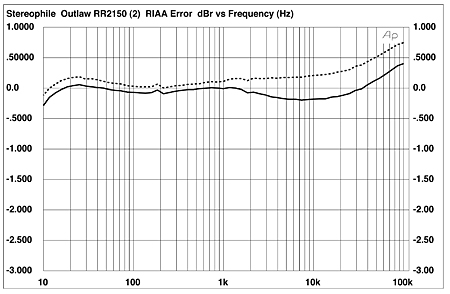
Fig.2 Outlaw RR2150, sample 2, RIAA error, MM input measured at preamp outputs (0.5dB/vertical div., right channel dashed).
The RR2150's output impedance was low, at <0.1 ohm at low and midrange frequencies, rising slightly to 0.16 ohm at 20kHz. The line-input frequency response, measured at the speaker terminals, was unchanged from that of the first sample, with a –3dB point at 61kHz. Line-stage S/N ratios were also unchanged.
I wrote in March 2006 that the original sample of the RR2150 was a powerhouse; it exceeded its 100Wpc specification by 1dB, delivering 125W into 8 ohms (21dBW) at clipping (defined as 1% THD), 190W into 4 ohms (19.8dB), and 310W into 2 ohms with one channel driven (18.9dBW). The new sample performed identically (fig.3), as it did when the THD+N percentage was plotted against frequency at 12.75V, equivalent to 20W into 8 ohms (fig.4).
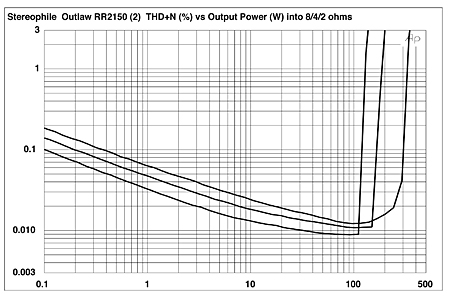
Fig.3 Outlaw RR2150, sample 2, distortion (%)vs 1kHz continuous output power into (from bottom to top at 10W): 8, 4, 2 ohms.
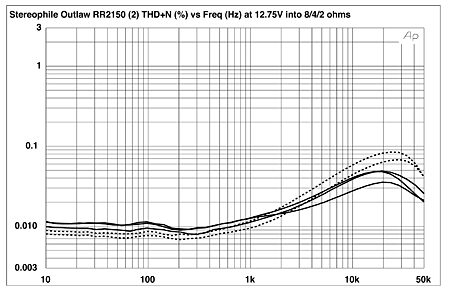
Fig.4 Outlaw RR2150, sample 2, THD+N (%)vs frequency at 12.75V into (from bottom to top): 8, 4, 2 ohms (right channel dashed).
As with the first sample, the spectrum of the distortion is predominantly low-order harmonics, even into low impedances (fig.5). Though the decrease in linearity at high frequencies seen in fig.4 results in some higher-order intermodulation products with an equal mix of 19 and 20kHz tones being driven at high levels into 4 ohms, the sidebands spaced at the ±120Hz power-supply frequency seen in the graph taken under identical conditions for the first sample, which I interpreted as revealing that the RR2150 was having to work very hard, are absent (fig.6).
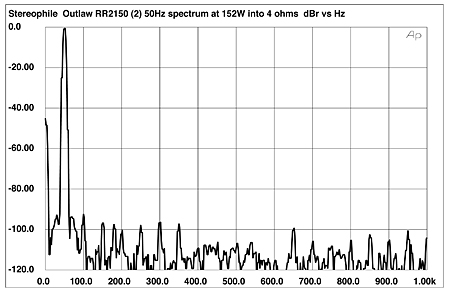
Fig.5 Outlaw RR2150, sample 2, spectrum of 50Hz sinewave, DC–1kHz, at 152W into 4 ohms (linear frequency scale).
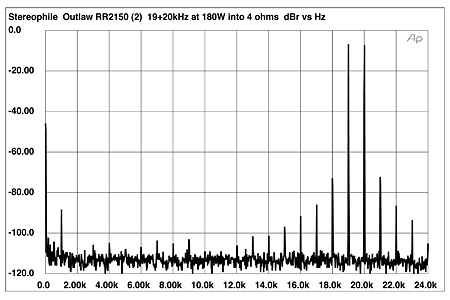
Fig.6 Outlaw RR2150, sample 2, HF intermodulation spectrum, DC–24kHz, 19+20kHz at 180W peak into 4 ohms (linear frequency scale).
A grounding problem had meant that I could not assess the original RR2150 DAC's performance via its USB input. I had no such problems with the new sample. It locked on to data at sample rates from 32kHz to 48kHz. When, from my Apple PowerBook, I fed it 16-bit/44.1kHz data representing a maximum-level 1kHz tone, the Outlaw's volume control had to be backed off to avoid clipping the receiver's preamp section. The USB input's frequency response, measured at the preamp output jacks, shows a slight rise in the treble, with a 0.4dB channel mismatch at low frequencies (fig.7).
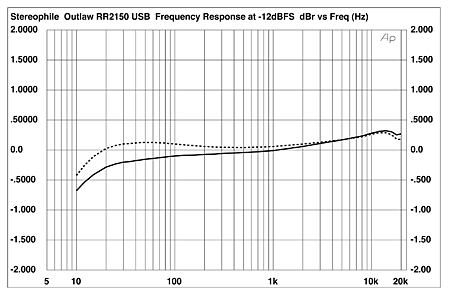
Fig.7 Outlaw RR2150, sample 2, USB input, frequency response into 100k ohms, 16-bit/44.1kHz data at –12dBFS (right channel dashed, 0.5dB/vertical div.).
Looking at the DAC stage's spectrum while it reproduced a 1kHz tone at –90dBFS, again measured at the preamp outputs, the tone peaked 4dB higher than it should, with a relatively high level of audioband noise and some harmonic components evident (fig.8). It looks as if the USB DAC is limited to about 14 bits of resolution. This rise in the noise floor can be seen in the RR2150's plot of linearity error (fig.9), and the limited resolution is made clear in the receiver's reproduction of an undithered 16-bit sinewave at exactly –90.31dBFS (fig.10). There is no trace of the three DC voltage levels that should be apparent with this waveform.
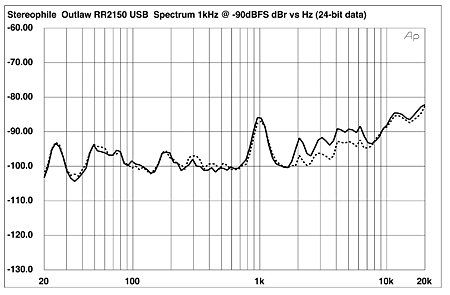
Fig.8 Outlaw RR2150, sample 2, USB input, 1/3-octave spectrum with noise and spuriae of dithered, 16-bit, 1kHz tone at –90dBFS (right channel dashed).
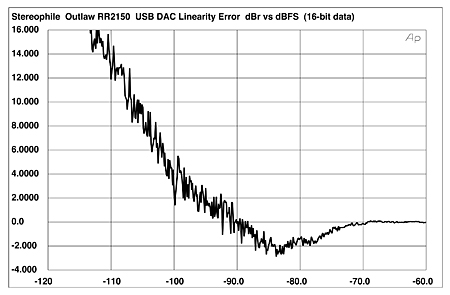
Fig.9 Outlaw RR2150, sample 2, USB input, left-channel departure from linearity, 16-bit data (2dB/vertical div.).
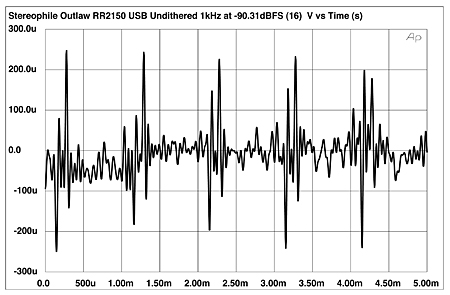
Fig.10 Outlaw RR2150, sample 2, USB input, waveform of undithered 1kHz sinewave at –90.31dBFS, 16-bit data.
The Outlaw's USB input was also disappointing when it came to harmonic distortion. Fig.11 is the spectrum measured at the preamp output while the DAC decoded data representing a full-scale 1kHz tone. The low-order THD (sum of the second through fourth harmonics) was indeed low, at 0.0081% left and 0.0043% right. But the string of higher-order harmonics seen in this graph is disappointing.
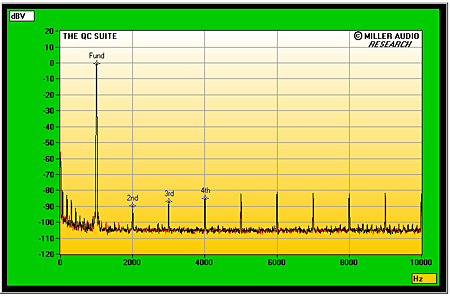
Fig.11 Outlaw RR2150, sample 2, USB input, spectrum of 1kHz sinewave at 0dBFS into 8k ohms (linear frequency scale).
Finally, though USB-transmitted data should be immune to the introduction of word-clock jitter in the data link, it does rely on the quality of the local clock oscillator. Feeding the RR2150 the Miller diagnostic tone gave the spectrum shown in fig.12. A large number of sidebands can be seen, as well as significant spreading of the central peak, due to random low-frequency jitter. The calculated jitter level was a very high 20 nanoseconds.
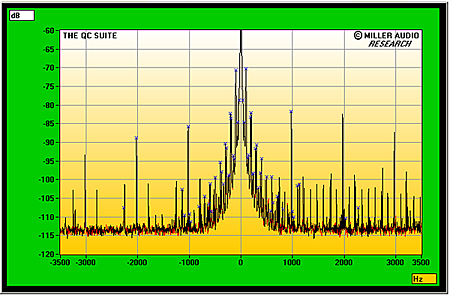
Fig.12 Outlaw RR2150, sample 2, USB input, high-resolution jitter spectrum of analog output signal (11.025kHz at –6dBFS, sampled at 44.1kHz with LSB toggled at 229Hz), 16-bit data sourced from Mac TiBook. Center frequency of trace, 11.025kHz; frequency range, ±3.5kHz.
As I said in the March 2006 review, the Outlaw RR2150 appears to be a rugged little powerhouse. It demonstrates that you don't have to give up an arm and a leg to get true high-end performance from an amplifier. However, I would regard its USB digital input as being for convenience only.—John Atkinson
Footnote 1: Originally priced at $599, the Outlaw now costs $649, and is sold factory-direct by Outlaw Audio, P.O. Box 975, Easton, MA 02334. Tel: (866) 688-5292. Web: www.outlawaudio.com.
- Log in or register to post comments




































